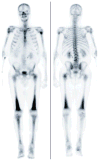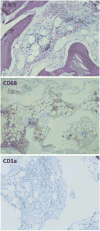FDG PET images in a patient with Erdheim-Chester disease
- PMID: 23640213
- PMCID: PMC3795958
- DOI: 10.1097/RLU.0b013e31828da5e6
FDG PET images in a patient with Erdheim-Chester disease
Abstract
Erdheim-Chester disease is an uncommon non-Langerhans-cell histiocytosis, due to excessive production of histiocytes deposited in various organs and tissues in the human body. FDG PET was performed in a 68-year-old man with documented active Erdheim-Chester disease to evaluate the extent of the disease. The patient was previously treated with high-dose subcutaneous Interferon α2b, 1,000,000 units 3 times a week, but treatment was interrupted approximately 5 weeks before evaluation at the National Institutes of Health because of adverse effects of the medication. FDG PET/CT showed lesions were imaged in brain, heart, mediastinum, abdomen, and skeleton.
Figures










References
-
- Drier A, Haroche J, Savatovsky J, et al. Cerebral, facial, and orbital involvement in Erdheim-Chester disease: CT and MR imaging findings. Radiology. 2010;255:586–594. - PubMed
-
- Brun AL, Touitou-Gottenberg D, Haroche J, et al. Erdheim-Chester disease: CT findings of thoracic involvement. Eur Radiol. 2010;20:2579–2587. - PubMed
-
- Shamburek RD, Brewer HB, Jr, Gochuico BR. Erdheim-Chester disease: a rare multisystem histiocytic disorder associated with interstitial lung disease. Am J Med Sci. 2001;321:66–75. - PubMed
-
- Haroche J, Amoura Z, Dion E, et al. Cardiovascular involvement, an overlooked feature of Erdheim-Chester disease: report of 6 new cases and a literature review. Medicine (Baltimore) 2004;83:371–392. - PubMed
-
- Haroche J, Amoura Z, Touraine P, et al. Bilateral adrenal infiltration in Erdheim-Chester disease. Report of seven cases and literature review. J Clin Endocrinol Metab. 2007;92:2007–2012. - PubMed
Publication types
MeSH terms
Substances
Grants and funding
LinkOut - more resources
Full Text Sources
Other Literature Sources

